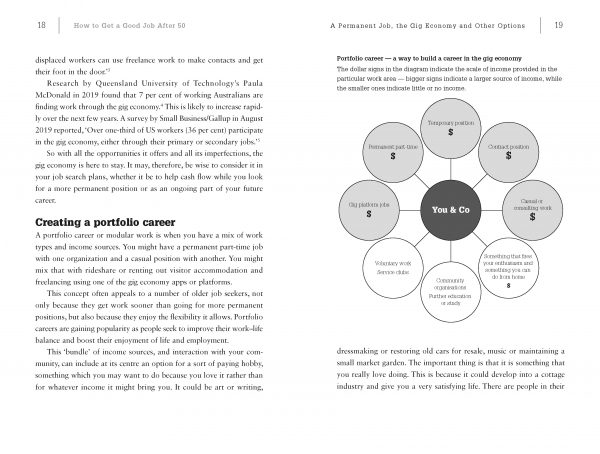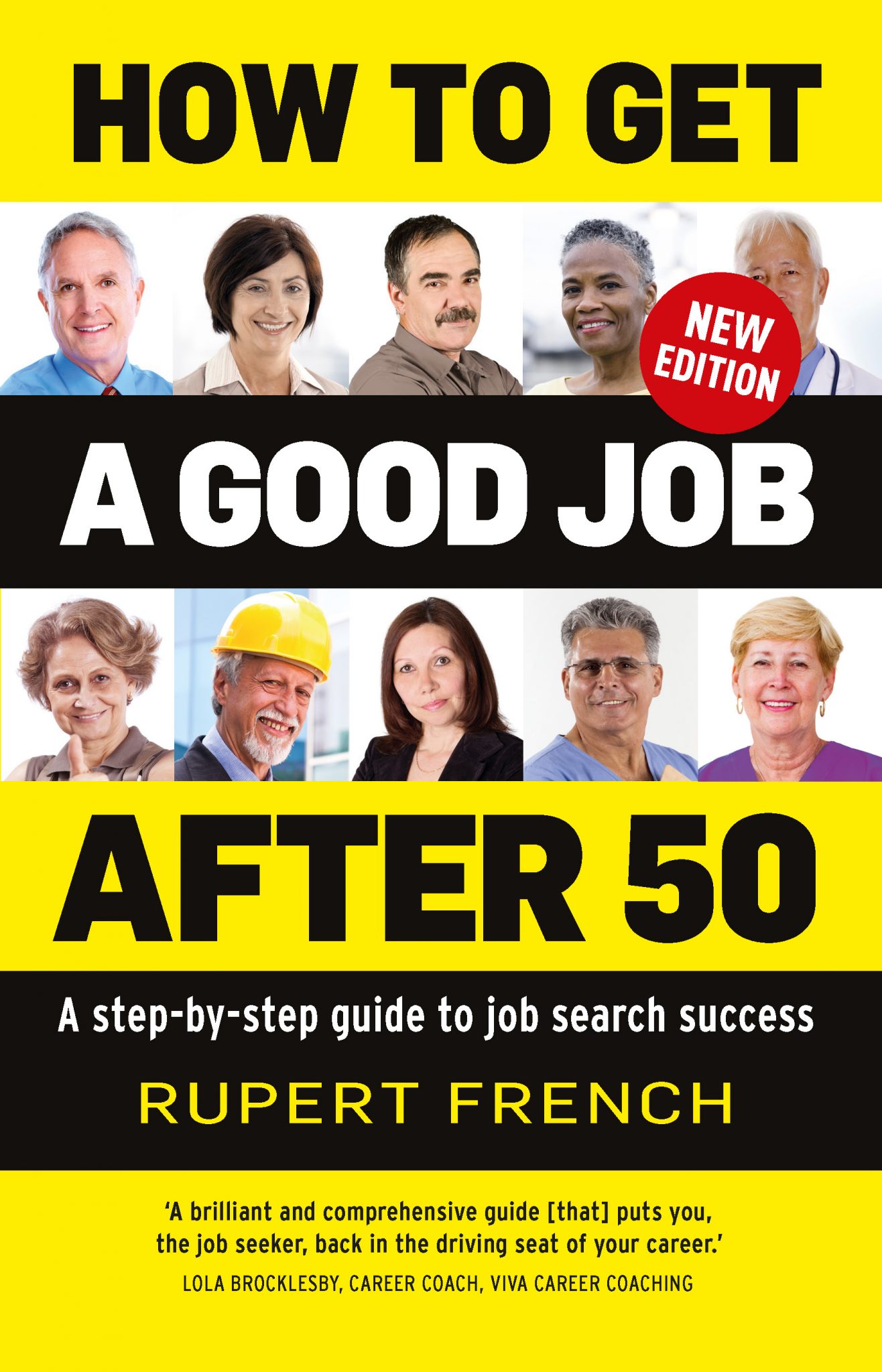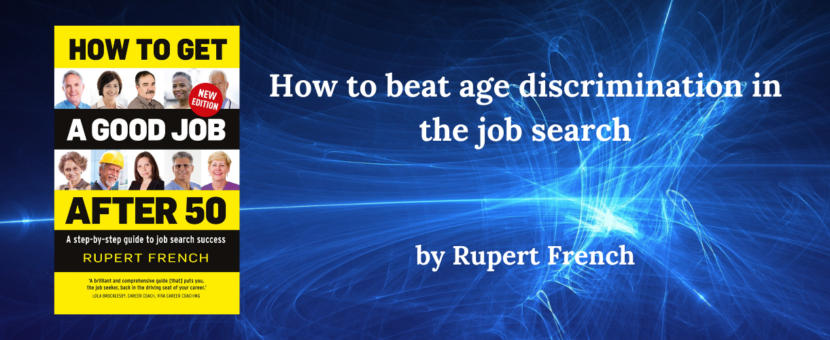Rupert French has been actively involved in helping job seekers for almost 40 years. In that time he has developed and delivered highly successful job-search training and coaching programs. He has also presented on effective job search methodology at numerous career conferences, both national and international.
The below article was written by Rupert to address the epidemic of Age Discrimination in the job search process and utilises tips and tricks found in his new book How to Get a Good Job After 50
How to beat age discrimination in the job search
By Rupert French
Age discrimination exists – and it’s not just employers who are infected with it. It’s the job seekers themselves who are the more seriously affected. You may have suffered too many knockbacks and you’re beginning to think no one is going to employ you because you are too old. Don’t be disheartened – you can beat age discrimination if you set about the job search in the right way.
To beat discrimination, job seekers need to work on two fronts: evading employer discrimination and totally obliterating any belief that they won’t get a job because of discrimination.
Discrimination is based on ignorance. Employers do not know what you could do for the organization; they do not know your qualifications and skills, and all the reasons you are right for the job, because they don’t get to know you before prejudice closes their minds to the benefits you could bring.
“Take control of the job search and be proactive. Identify the sort of work you want to do, the specific occupation. This is what you need to focus on.”
Because it is based on ignorance, it can be beaten. All you have to do is to demonstrate, preferably in person, the advantages of taking you on. This is not difficult if you are confident in your abilities to do the job and to establish a good rapport with people from the employer organization.
So let’s first tackle the problem of how discrimination affects you, the job seeker.
Prevent discrimination from undermining your confidence
This component could be the more difficult part of the battle but it is certainly the more important. It’s hard to make progress in what is already a stressful process if you allow the fear of discrimination to white-ant your confidence and morale.
Therefore the first priority is to work on your confidence. A daily exercise routine, walking and standing tall, dressing every day as if you were going to work, these are all effective strategies to boost confidence and self-esteem. Gather a support group, a few people you know and trust, and ask them to provide you with encouragement and advice. Collaborating with other job seekers is another helpful strategy.
Take control of the job search and be proactive. Identify the sort of work you want to do, the specific occupation. This is what you need to focus on. Don’t allow yourself to be distracted by other positions which you could do at a pinch; go for the one you really want. Seriously, you are more likely to get a position for which you are motivated than one which interests you less. And generally you’ll get it sooner because employers will be able to see your motivation.

Then determine the qualifications and personal qualities employers are looking for, the selection criteria. You can use an online advertisement or position description for this purpose. Now think of specific events when you have demonstrated these qualities. List them under the appropriate criterion – then write them up as achievement, or accomplishment, statements. If you have access to the new edition of How to Get a Good Job After 50, read chapter 6, ‘the sizzle that sells the story’ which explains in detail how best to do this.
As the list grows, you will find your confidence growing and you will also find it a brilliant resource for your résumés and for preparing answers to possible interview questions. Achievement statements are a very convincing way of describing your capabilities without sounding boastful.
“One often touted strategy to get around age discrimination is to take steps to conceal your age on your résumé. There are a number of significant disadvantages to this approach.”
Don’t wait for the right job to be advertised; get out and find it before it is advertised. This may sound daunting but it’s the method used by the most successful job seekers and, providing you are using the strategies described above and that you have strong backing from a support group and/or collaborating with other job seekers, you should be able to use this strategy to your advantage.
Carefully research how to network; it is important to do it properly to win people over and convince them that you are worth hiring. Read chapter 11, ‘Goodwill, market research and networking’; it will guide you through the process.
Research shows most employers prefer older workers
In spite of widespread age discrimination, research around the world shows that, when they stop to think about it, a majority of employers actually prefer older workers. In spite of continuing discrimination against older workers, there is strong statistical evidence that many employers would prefer to hire workers over 50 to those under 30. According to a survey by Adecco of 500 hiring managers, 60% answered that, given the choice of hiring a millennial or someone over 50, they would hire the mature worker.
The reasons for this are that older workers are seen to have a good work ethic; that they are more reliable and responsible; and that, because they have experienced difficult situations and crises in the past, they are good problem solvers and are able to help and mentor their younger colleagues.

One 2017 study published in Forbes showed that productivity does not peak until age 50 when it is 60% higher than that of the average 20-year-old. Far from being a health risk, older workers statistically have fewer sick days than younger workers, according to a report in The Independent.
If you are an older job seeker, there are a lot of benefits your age and experience can bring to the organization so, instead of trying to hide your age, highlight its advantages. In fact, in the book, chapter 4, pages 53-54, stating your date of birth has advantages for older job seekers as long as you are confident that your résumé is not going to be first screened by ATS software.
Trying to hide age on résumé is deception
One often touted strategy to get around age discrimination is to take steps to conceal your age on your résumé. There are a number of significant disadvantages to this approach. Firstly, in trying to hide your age, you may have to leave out things which would otherwise strengthen your candidature such as winning an industry award some years ago.
More important is the danger of employers getting a whiff that you are trying to hide something and this would lead to loss of credibility and, as a result, any chance of getting the job.
A much better approach is to be proactive and demonstrate your value proposition, the things you would like to do for the organization and the benefits you want to bring.
There are two ways to demonstrate your value proposition and you would be well advised to do both. They are not ‘either / or’; they confirm each other and strengthen your case.
1. Pack application with achievement statements

The first, and the easier of the two, is to pack your written application with achievement (or accomplishment) statements. These provide evidence of what you are capable of, your initiative, energy and drive, your ability to collaborate with team members and your motivation to achieve corporate goals.
Examples of recent achievements are obviously more convincing than older ones but that doesn’t mean that older ones should be left out if they strengthen your application. And statements describing specific accomplishments are more convincing than ones which are more general in nature.
So let’s have a look at what achievement statements are and explain how to compose them.
There is an infinite number of ways to describe your achievements but saying that doesn’t help you compose them. Instead, let’s look at the two different types of statement you are likely to use most – the Classic and the STAR. The great thing is there is a formula for each one to get you started. For more on achievement statements, see chapter 6, ‘The sizzle that sells the story’.
The ‘Classic’ achievement statement
The Classic is a short, usually single-sentence, statement which succinctly describes a single event. The formula is ‘Action verb’, ‘What’, ‘Where’ and ‘When’. For example:
Negotiated new work rosters on behalf of my team, Karagoola Canning, 2016.
Action verb: ‘Negotiated’; What: ‘new work rosters on behalf of my team’; Where: ‘Karagoola Canning’; and When: ‘2016’.
Here are some more examples:
Increased sales by 20% in the first 12 months after my appointment as Head of Hardware, Mangalore General Store, 2015.
Organised the itinerary, travel arrangements, accommodation and matches for the Under-19 team’s tour of southern NSW, September 2019.
And here’s one with a bit added to it:
Compiled all weekly and monthly financial reports at the Natural Warmth Shop, 2019, while the Manager was away. Was complimented by the accountant for handling it so efficiently with little training.
Notice that the pronoun ‘I’ has been left out. This is deliberate. ‘I did this’ and ‘I did that’ can get to sound a bit like bragging and that can put readers off. And it’s not necessary; anyone can understand that the résumé is talking about you and not anyone else.

The STAR
STAR is an anagram for the formula: Situation, Task, Action, Result. In one way, it is like a longer Classic in that it tells the story of a specific accomplishment.
Don Bradley* is applying for Technical Services Manager for a local government municipality. Here is a STAR describing one of his achievements:
Land use planning: a local dairy farmer sought planning permission to set up and operate a boutique cheese factory in 2018 while I was acting Manager, Engineering Services. I took the farmer through the whole process, ensuring that his proposals met all local government requirements as well as state and federal regulations. This included checking his building plans for structural soundness, food hygiene requirements, OH&S factors, water and sewerage, and transport access.
The factory has now been built and the cheeses produced there have already won medals at agricultural shows.
Situation: ‘a local dairy farmer sought planning permission to set up and operate a boutique cheese factory in 2018 while I was acting Manager, Engineering Services’; Task / Action: ‘I took the farmer through the whole process, ensuring that his proposals met all local government requirements as well as state and federal regulations. This included checking his building plans for structural soundness, food hygiene requirements, OH&S factors, water and sewerage, and transport access’; Result:’ The factory has now been built and the cheeses produced there have already won medals at agricultural shows’.
2. Demonstrate in person by running proactive job search campaign
Even more convincing than an application packed with achievement statements is you, in person, demonstrating the qualities the employers are looking for. This is best done by adopting a proactive approach to the job search.
To quote résumé expert, Jessica Holbrook:
‘Being a proactive job seeker means you’re taking an active role in finding your next opportunity. Instead of sitting back and waiting for the perfect position to cross your path, you’re going out to find it. Not only can this be a more empowering and less frustrating position to be in, it also produces more interviews and offers in less time.’
Instead of making job boards your main source for finding possible positions, choose the sort of position you want, and the organizations you would like to work for, research them, identify possible contacts within those organizations, contact them and demonstrate your capabilities in person. For more on this, read my article, ‘Four steps to develop and demonstrate a can-do attitude and win that job.’
A proactive approach like this has two great advantages over conventional job search. Firstly you get to demonstrate your confidence, work ethic, initiative, interpersonal and communication skills in the most convincing way and secondly, because you would frequently be applying for positions before they are advertised, you eliminate younger competition.
It may get you temporarily outside your comfort zone, but it will almost certainly win you a job of your choosing much sooner than would just relying on conventional job search.
Wrapping it up
There is no doubt that age discrimination exists but it can be avoided if you use the right strategies. Take the initiative to convincingly demonstrate the skills and personal qualities employers are looking for both in your application and, better still, in person. For more detailed information on how to do this, please read the revised edition of my book ‘How to Get a Good Job After 50’. Then, with confidence, go out to find and win the sort of job you really want.
*Don Bradley and the sample achievement statements are figments of my imagination. Many of them are taken from my book, How to Get a Good Job After 50.



